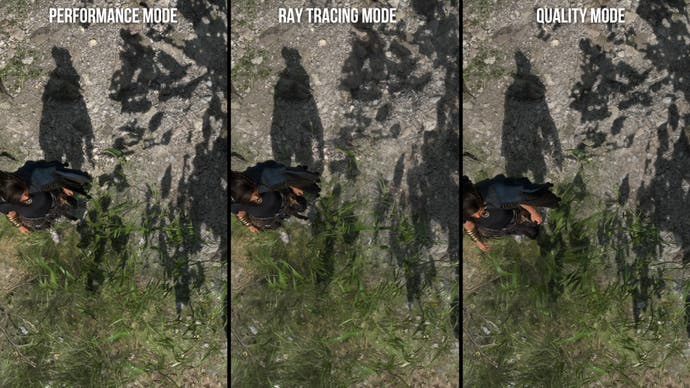The Forspoken demo: six graphics modes to choose from but what do they do?
Our first hands-on look at the next Square-Enix epic.
Forspoken was one of the most intriguing early demos for the PlayStation 5. Based on a brand-new IP and developed by Luminous Productions - the Square Enix development group that produced Final Fantasy 15 - expectations were high and the early footage definitely impressed. Now, after multiple delays and two and a half years of additional development, Forspoken is finally here, or a demo version of it at least. Ahead of the game's January 2023 release, Square Enix has released a lengthy playable sample on PS5, allowing players to complete a variety of content in an open-world space. We were interested to see whether the demo lived up to the promise of initial media and also how the six visual modes compare.
First of all, I think it's worth noting that the Forspoken demo isn't like most other game demos. This is a pretty substantial taste of the full game, with several hours of content spread across a vast space. Narrative is kept to a minimum, but you get a good sense of how the game actually plays - and I generally liked what I saw. Combat is fast, fluid, and reminiscent of battle sequences in prerendered Final Fantasy media. It's relatively simple to control, combining basic attacks, a dodge, and a mix of special abilities, but the fighting feels fantastic in motion. It feels a bit like the combat from Final Fantasy 15, but with a greater focus on real-time battle and with a lot more polish.
The action is definitely the visual highlight of this demo as well. There are a lot of great-looking combat animations that flow smoothly into one another with plenty of bespoke animations for common actions like dodges depending on player positioning. Each move is punctuated with an explosion of particles, which feels satisfying, particularly for the screen-filling special attacks. Square Enix has made valiant attempts to emulate the acrobatic combat from their CG movies in other games, but this is the closest effort yet.
Exploration is similarly frenetic. The player has a "magic parkour" system that allows you to zip through environments at high speed by timing presses of the circle button. Leaping through areas is just as simple, though the animations are context-sensitive and can feel a bit unpredictable. It's not quite as successful as the combat perhaps, but it's more interesting than the typical open-world fare - and a fun traversal system is critical to building an entertaining open-world game. Superhero games, like Infamous, seem like a clear inspiration for some of these abilities.
I think that Forspoken is a good-looking title, judging from what we've seen so far - but there are some definite issues as well, including some problems I really didn't expect to see from a current-gen exclusive game. This is an early teaser but I found lighting to be a mixed bag - sometimes beautiful, but with some problems on inconsistent lighting and light leakage in interiors.

Distant shots over the open world also look a little flat, owing to the lack of distance shadows (something the ray-traced shadows option does not fix), while screen-space reflections and accompanying fallback for cubemaps can be unconvincing. For a cross-gen game, these issues wouldn't stand out too much but Forspoken is a current-gen only title, with releases announced only for PS5 and PC. Beyond the assets, which do seem to be a cut above a typical last-gen open world title, it's hard to imagine Forspoken in the same league as some of the other big current-gen only releases, or among the more accomplished cross-gen fare.
It's important of course to provide the caveat that we're seeing a small, early slice of a presumably much larger game, and the final game may improve significantly from this showing. Plus, Forspoken is definitely still a good-looking title, particularly in the heat of battle when particles are flying - but so far, I feel the jury is out on the effectiveness of the overall package.
Still, the Forspoken demo is remarkably fully-featured - and that extends to the graphical options, where six different presentational modes are on offer, three apiece for 60Hz and 120Hz display. Looking at the 60Hz modes first, all three are similar. Between the performance and quality modes, the only meaningful difference seems to be an improvement to environmental density at a distance - LODs for far-away geometry are better, though it's only really noticeable in head-to-head comparisons. The ray tracing mode generally corresponds to the performance mode in terms of visual settings, so distant geometry is slightly pared back. Beyond that, it's surprisingly difficult to spot evidence of ray-tracing during typical play. Shot after shot looks virtually identical to the performance mode - and as the video reveals, the effectiveness of the RT shadows is dubious.


Beyond those differences, the only visual differentiator between the modes is image quality. In stills, the RT and quality modes look very similar, with a fairly 4K-like presentation. The performance mode is softer and visibly less detailed in comparison, though it's not a massive difference. AMD's FSR2 is mostly likely used to reconstruct a lower resolution image into a higher resolution one, and the amount of scaling does vary per mode. Performance mode is typically around 900p internally, RT mode is usually around 1000p or so, and quality mode clocks in at about 1296p in most shots I tested. The pixel count did seem to vary on a frame-by-frame basis so dynamic resolution does seem active as well.
If I had to make a guess here in advance of the full release, I would say the RT and quality modes are reconstructing to 4K and the performance mode is reconstructing to a lower target resolution. The image is uniformly blurrier in the performance mode, and certain 2D elements also appear visibly less sharp, indicating a lower HUD resolution that likely is in line with a reduced-resolution reconstruction target for 3D content. Image quality overall is pretty good overalland a lot of the reconstruction issues are masked by motion blur, which was disabled in early Forspoken showings but is present by default here. Certain alpha effects have a visibly low-res resolve but overall the game presents a sharp picture, though we'll have to wait for final code before making a real conclusion.
Frame-rates in this demo are unstable, though this isn't unexpected for an early sample that is likely based off of old code. In the performance mode Forspoken is frequently dropping frames during traversal, and is very often sub-60fps during battles, with readings around 40fps at worst. The quality mode and ray tracing mode are more consistent, though they target 30fps. Traversal is a solid 30fps in those modes, and battles are mostly 30 though they do drop significantly at times, with both modes hitting similar framerates in intense moments.




The modes available at 120Hz output are a bit more interesting. The performance mode is pretty unassuming - the frame-rate target is still 60fps, with drops around 40fps at worst during battles. However, both the quality and ray tracing modes now target 40fps. They do drop in battle, though not quite as hard as at 60Hz, coming in around 30fps at worst. Traversal seems to be a locked 40fps, so in general the performance level is significantly higher than the 60Hz alternative. All of these modes appear to use similar visual settings to their 60Hz counterparts. It's possible that the internal resolution is cut back somewhat to achieve higher performance targets, though the actual final image across the 60Hz and 120Hz mode variations appears very similar.
Square-Enix deserves commendation for the Forspoken demo. This is a big playable chunk of an upcoming big-budget release, available for free without any conditions. Once you get a handle on the combat I do think this is one of the more exciting action-RPG fighting systems out there, at least when it comes to visual splendor. I'm also really impressed by loading times which are essentially unnoticeable at 1.3 seconds, whether you're joining the game from the main menu or using fast travel. We've seen games that load quickly on current-gen consoles but this feels lightning quick, matching or exceeding the speed of the most rapid-loading titles.
But putting the moment-to-moment pyrotechnics and wait-free loading aside, Forspoken doesn't seem to be harnessing current-gen consoles as well as a lot of other recent games. There are a handful of key areas for improvement where I hope to see some progress once we get our hands on the final code. Performance is shaky as well in this build, though it's hard to make a judgment at this early stage. To Square Enix's credit, after putting about eight hours into this demo I am looking forward to seeing how the final game turns out. But I'm also hoping that the finished code builds on this sample to create a more visually mature experience.






.png?width=291&height=164&fit=crop&quality=80&format=jpg&auto=webp)

